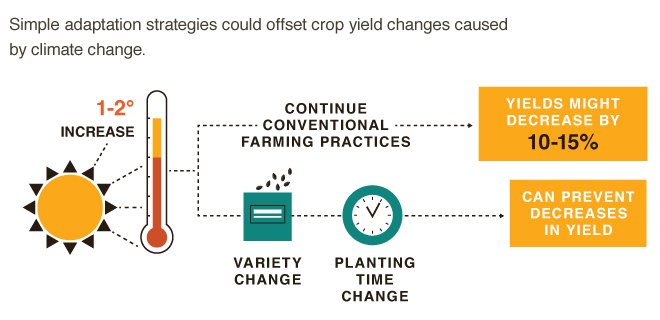Post Production

Facts
- Adaptations to climate change that address food availability range from improving storage facilities to securing formal credit, land rights, tenure and market access (input and output markets) for small-scale farmers. These farmers also need to be better able to manage the risks associated with climate change (for example, through index-based crop insurance), support for traditional land management and knowledge systems and better access to climate information (Howden et al. 2007).
- Adaptation measures addressing food access include improved access to food aid following climate shocks and other social safety nets (for example, income support) and policies that reduce food price variability and volatility (Ziervogel and Ericksen 2010).
- Adaptation strategies that address food include support for increased dietary diversity, allowing diets to change with climate but also to remain relevant to local cultural and health needs. Food adaptations also include policies that address food-related health threats associated with food safety changes under climate change (Lake et al. 2012).
- Households, particularly poor farming households, need to be better able to manage climate-related risks to help them withstand the effects of increasing climate variability. Formal insurance products can supplement traditional risk management measures, such as transfers of money and produce among families and neighbours (Hertel and Rosch 2010).
- People suffering the effects of climate shocks such as droughts will need food aid to help underpin the nutrition, growth and well-being of small children in particular. Food aid in Ethiopia, for example, can prevent a 1.8% decrease in the growth of babies (6 months–2 years old) that occurs in the six months following a lost harvest. Without food aid, the negative impacts of these events last for life, reducing educational attainment and earnings (Alderman 2010).
- Increasing trade within and between countries could be an important adaptation strategy for food security under climate change. However, better trade links do not always benefit poor people because they expose them to prevailing global food prices (Hertel and Rosch 2010).
- Where incremental changes in farming and food systems don’t keep pace with climate change, transformative adaptation may be needed. This could include providing assistance to people to get out of agriculture or to migrate to other areas (Thornton et al. 2012).
Sources and further reading
- Alderman H. 2010. Safety nets can help address the risks to nutrition from increasing climate variability. Journal of Nutrition 140:148S–152S. (Available from http://dx.doi.org/10.3945/jn.109.110825)
- Hertel TW, Rosch SD. 2010. Climate change, agriculture, and poverty. Applied Economic Perspectives and Policy 32:355–385. (Available from http://dx.doi.org/10.1093/aepp/ppq016)
- Howden SM, Soussana, J-F, Tubiello FN, Chhetri N, Dunlop M, Meinke H. 2007. Adapting agriculture to climate change. PNAS 104(50):19691–19696. (Available from http://www.pnas.org/content/104/50/19691.abstract)
- Lake IR, Hooper L, Abdelhamid A, Bentham G, Boxall AB, Draper A, Fairweather-Tait S, Hulme M, Hunter PR, Nichols G, Waldron KW. 2012. Climate change and food security: health impacts in developed countries. Environmental Health Perspectives 120(11):1520–1526. (Available from http://dx.doi.org/10.1289/ehp.1104424) (Accessed on 5 November 2013)
- Thornton P, Cramer L, eds. 2012. Impacts of climate change on the agricultural and aquatic systems and natural resources within the CGIAR’s mandate. CCAFS Working Paper 23. Copenhagen: CGIAR Research Program on Climate Change, Agriculture and Food Security. (Available from http://cgspace.cgiar.org/handle/10568/21226) (Accessed on 5 November 2013)
- Ziervogel G, Ericksen PJ. 2010. Adapting to climate change to sustain food security. WIREs Climate Change 1:525–540. (Available from http://dx.doi.org/10.1002/wcc.56)